This article was written by Matthew Allard, from https://www.newsshooter.com/2022/08/29/chiopt-xtreme-zoom-75-250mm-t3-2-review/
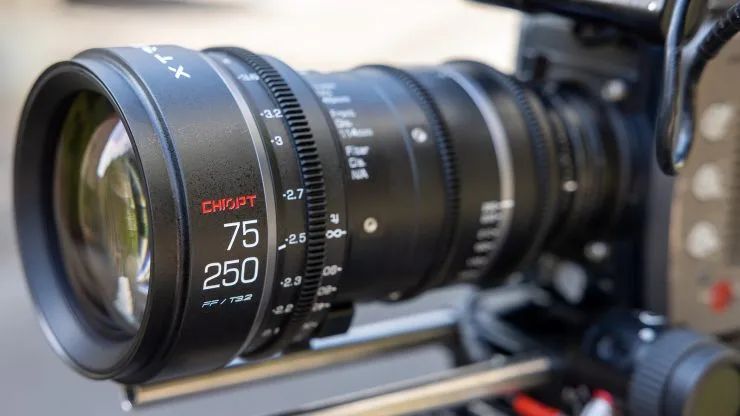
The CHIOPT XTREME Zoom 75-250mm T3.2 is the second lens in a new Xtreme series. Xtreme is a contemporary cinema lens series that will consist of multiple full-frame cinema lenses.
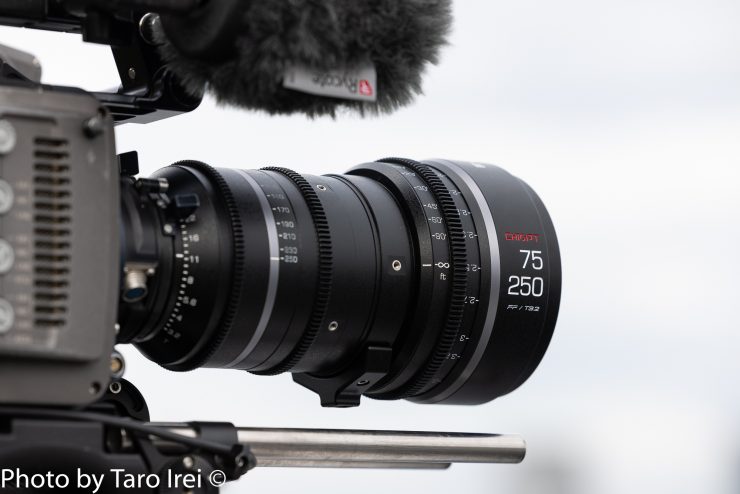
The CHIOPT XTREME Zoom 75-250mm T3.2 is an interesting lens because it provides a focal range that no other affordable cine lens manufacturer is offering.
I reviewed the first lens in the series, the XTREME Zoom 28-85mm T3.2. You can see that review here. While I did find that lens was a little soft when used wide open at longer focal lengths, it was a solidly made, well-performing lens for the price.
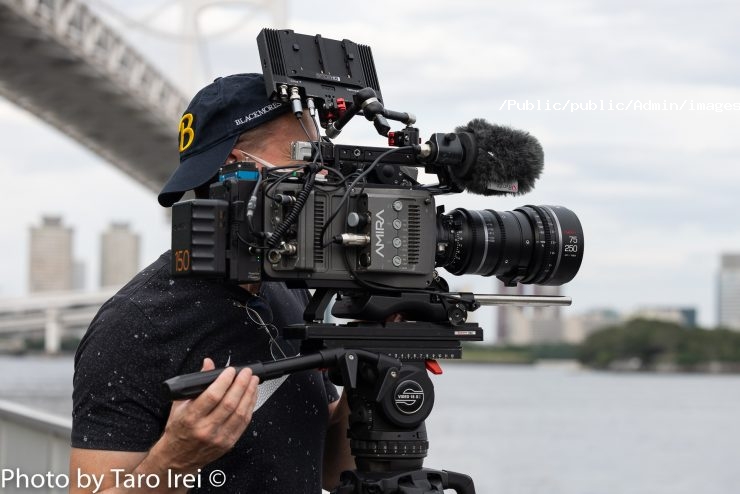

CHIOPT is a Chinese company that has been around since 2012. They mainly specialize in making industrial and security lenses and they have over 700 employees.
They have recently branched out into making cine lenses. CHIOPT is looking to cooperate and get involved with more distributors around the world in the development, customization, and OEM of cine lenses.
If anyone is interested they can contact yaokai@chiopt.com
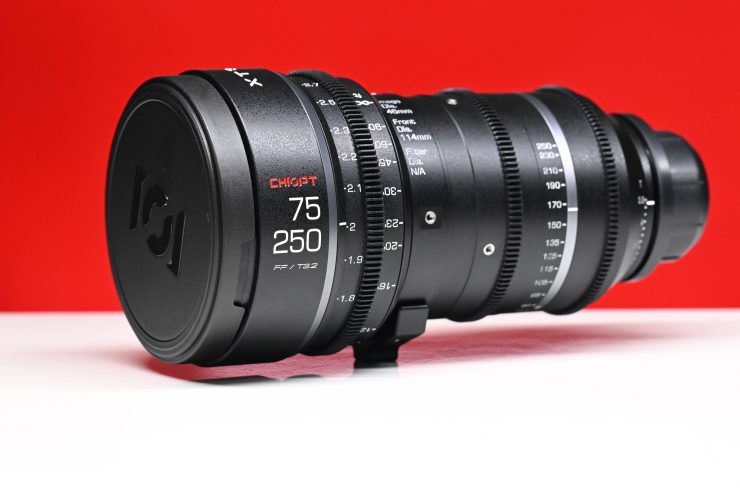
There are quite a lot of affordable S35 cine zoom lenses on the market, and while we have started to see more full-frame options becoming available, they all have limited focal ranges.
I don’t personally don’t know of any other affordable cine zoom with a focal range anywhere near 75-250mm.
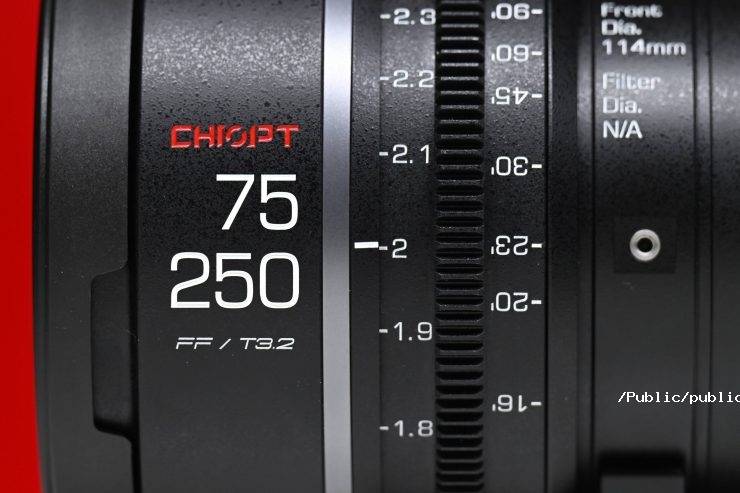
With most cameras coming out having full-frame and larger sensors, there has been a gaping hole in the market for affordable cine zooms.
Plenty of affordable full-frame and larger cine primes have come out in the last few years, but it is a lot harder to make a zoom than it is a prime.
It is also harder to make a lens with a long focal reach and to keep it reasonably compact and lightweight.
Focal Range

One of the biggest caveats of using a full-frame or larger sensor digital cinema camera is that the lenses become larger, heavier, and have reduced focal ranges. This is especially true when it comes to cine zooms that cover large image circles. The CHIOPT has a focal range of 75-250mm, which is a great range given its size and weight.
A lot of factual shooters who were using DSLR or mirrorless cameras used to almost always have a 70-200mm in their kit bag. Canon’s EF and RF mount 70-200mm lenses are still extremely popular with shooters and why nobody has recognized this and made an affordable cine version up to now is a head-scratcher. Yes, there have been companies like G.L Optics who were rehousing the Canon 70-200mm, but no one has made a ground-up cine lens with this range that is affordable. If you have plenty of cash to spend there is the Fujinon Premista 80-250mm T2.9-3.5, Zeiss 70-200mm T2.9 Compact Zoom CZ.2 Lens, and Cooke 85-215mm Varotal/i Full Frame Zoom Lens, but all of those options are not lenses a lot of people can afford to buy.
Image Coverage
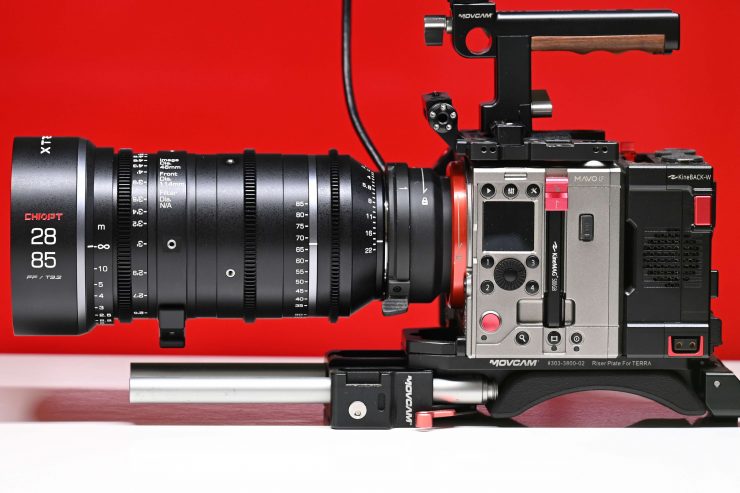
The lens covers image circles of up to 46mm, so it can be used on almost all of today’s modern digital cinema cameras.
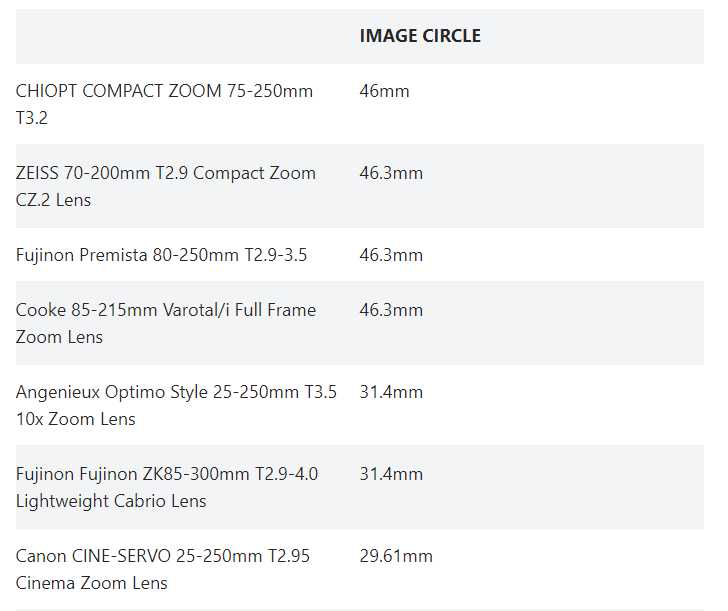
Above you can see what the image circle coverage is for some of the other full-frame and S35 cine zooms with similar focal lengths.
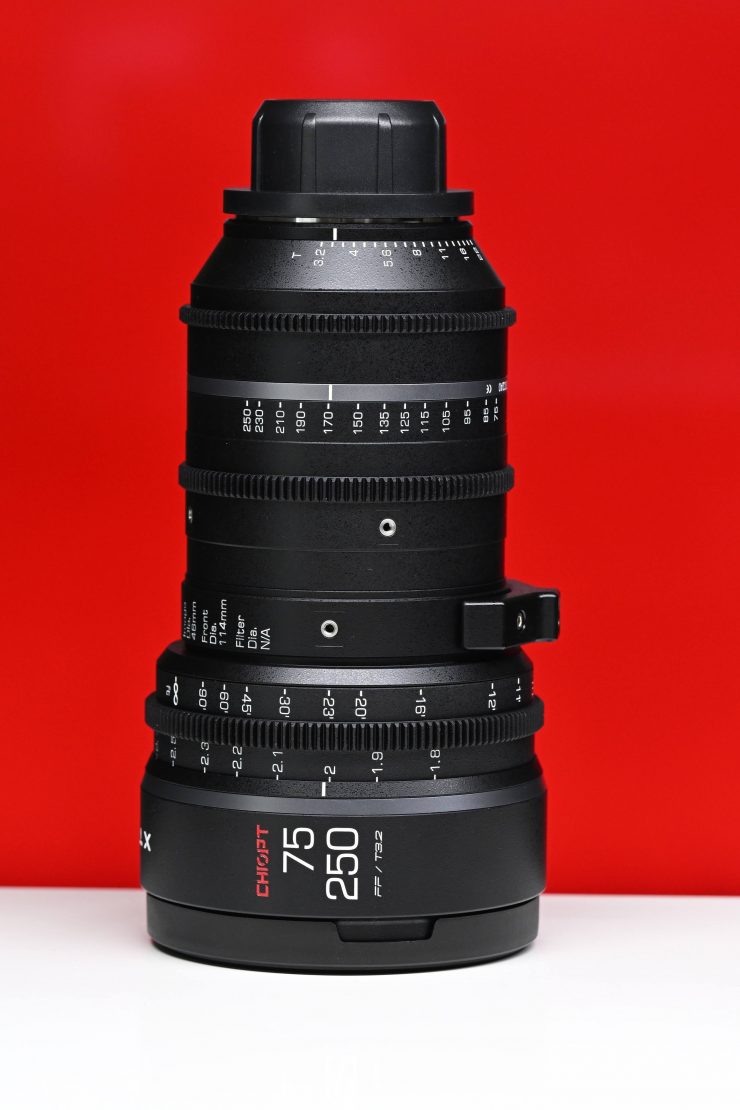
If you are a relatively unknown company and you are going to launch a new product into a sector where people have never heard of you before then you need to make a good first impression.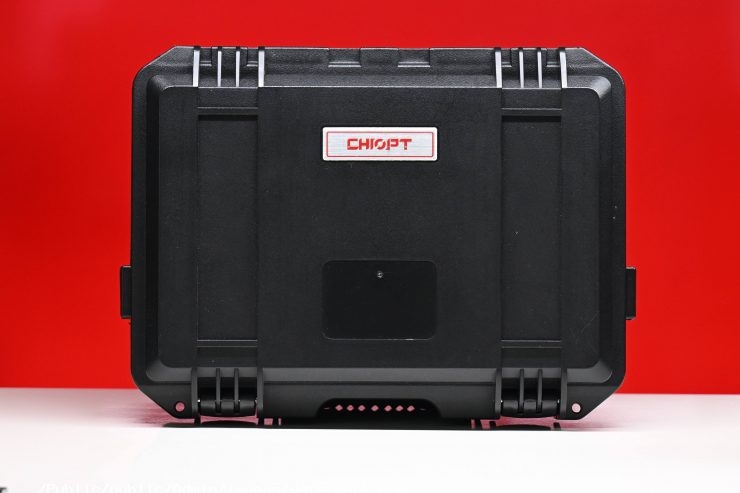
Just like with the 28-85mm T3.2, the 75-250mm T3.2 came in a nicely presented box, and inside that box was a custom hard case. It is good to see that they have paid attention to small details like presentation.
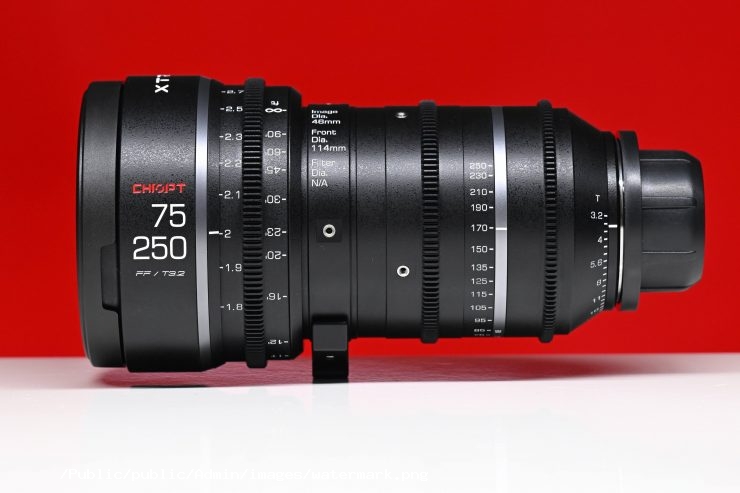
The CHIOPT COMPACT ZOOM 75-250/T3.2 tips the scales at 2.9 kg / 3.39 lb (PL Mount).
This is not a light lens by any stretch of the imagination, however, as far as full-frame cine zooms lenses go with this focal range and constant T-stop it is pretty good.

Above you can see how the weight compares to other similar focal length cine zooms and a couple of S35 options with slightly bigger focal ranges.
The CHIOPT COMPACT ZOOM 75-250mm T3.2 is a similar weight to the Zeiss 70-200mm.
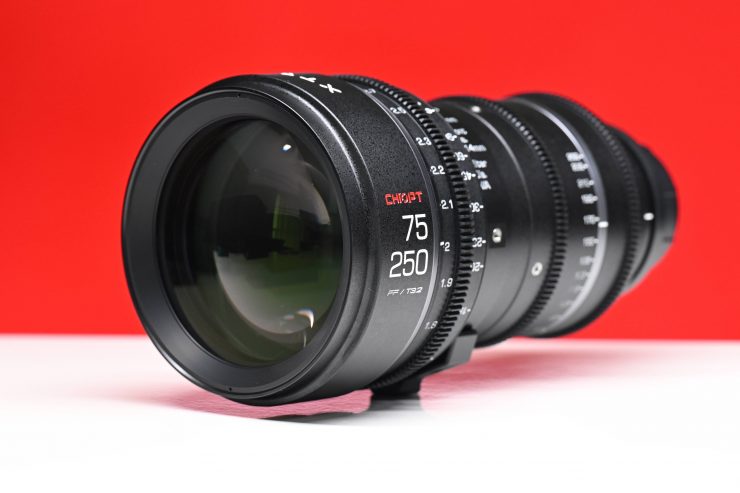
It is always hard to know what to expect with a new lens from a company you haven’t heard of before. Just like the CHIOPT COMPACT ZOOM 28-85mm T3.2, the 75-250mm T3.2 is reasonably well made and constructed. The outside of the lens casing is a hard metal and it has been designed in a matte black finish to avoid light reflecting off it.
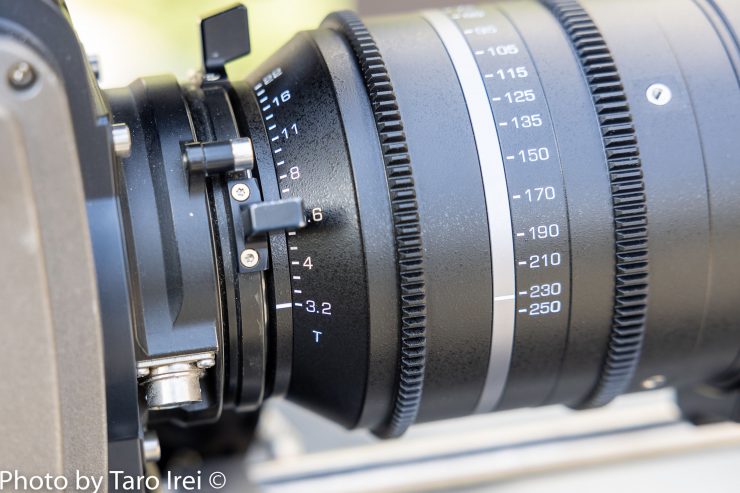
You have to remember that this is an ‘affordable’ cine zoom and you shouldn’t expect it to have the same build quality as much more expensive lenses.
The focus ring is reasonably well-weighted and the operation is very smooth. The overall build quality is very good considering how much this lens costs.
CHIOPT has listened to feedback from users of the prototype and made changes from there.
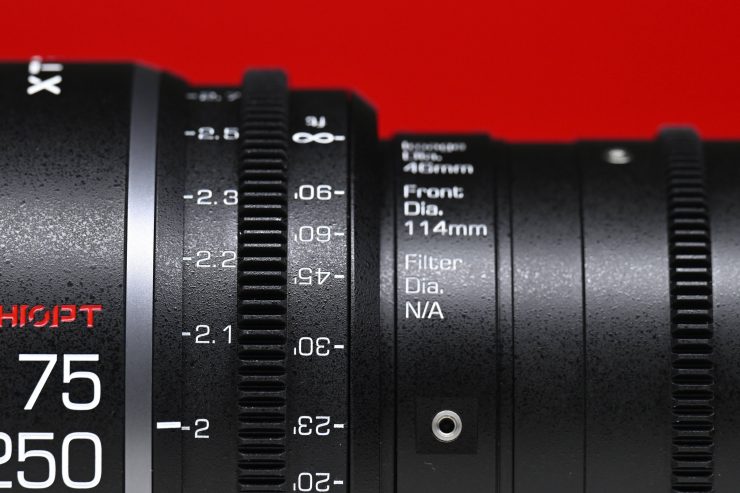
The focus rotation is 288-degrees which is a slightly odd number, however, it is so close to 300 degrees that I doubt most operators could tell the difference.
If you are pulling focus by hand you will find it virtually impossible to go from the minimum focus to the maximum focus point, but this is true of most cine primes and zooms.

The zoom ring is more heavily dampened than the focus ring but this is fairly common with cine zooms because you don’t necessarily want to accidentally bump the focal range.
It is still smooth to use and operate.
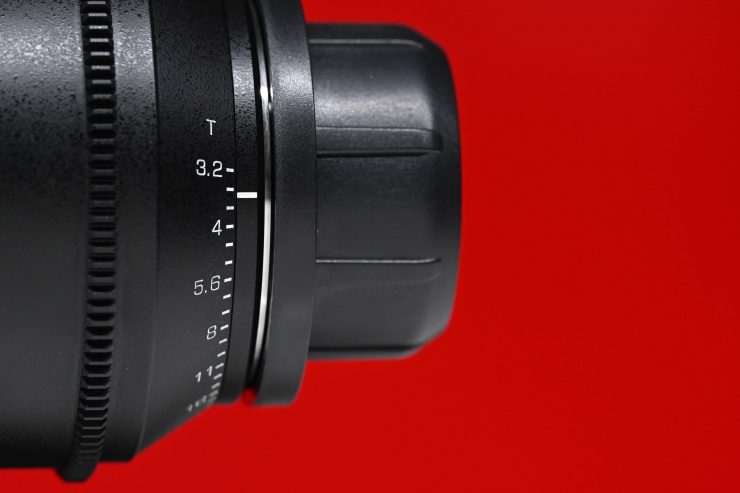
The iris is nicely weighted and I found it easy to use and operate.
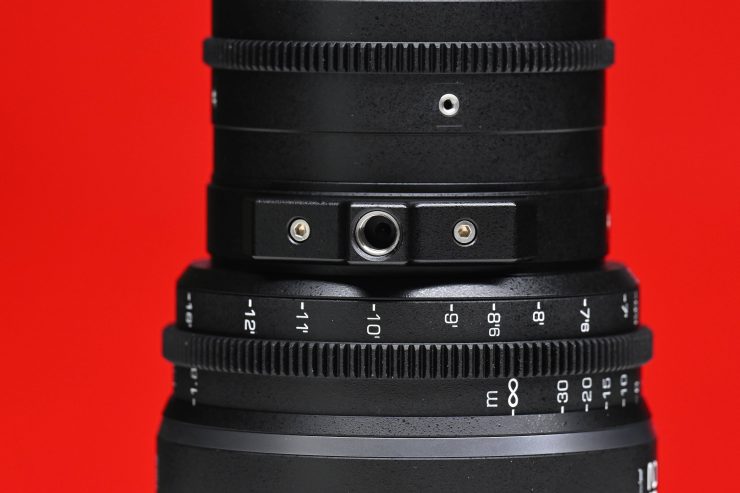
There is a built-in lens support adapter that takes a 1/4-20″ thread.
Optical Design
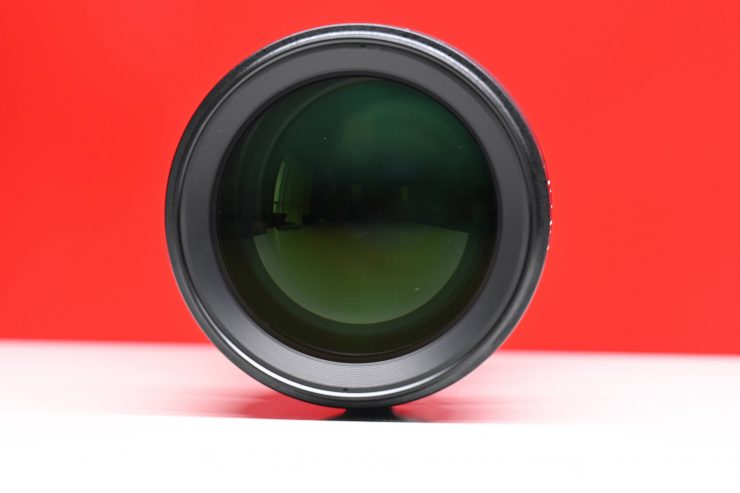
CHIOPT doesn’t list how many groups and elements are in the optical design, however, I can tell you that it has 11 aperture blades.
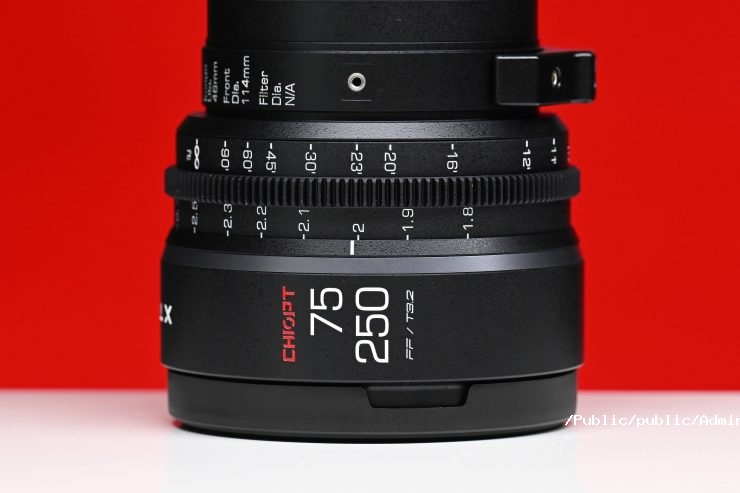
The lens is claimed to feature a parfocal design and well-controlled breathing.
The minimum focusing distance from the front of the lens is 1.5m / 4.92′, this is the same as the Fujinon Premista 80-250mm T2.9-3.5. The front lens diameter is 114mm.
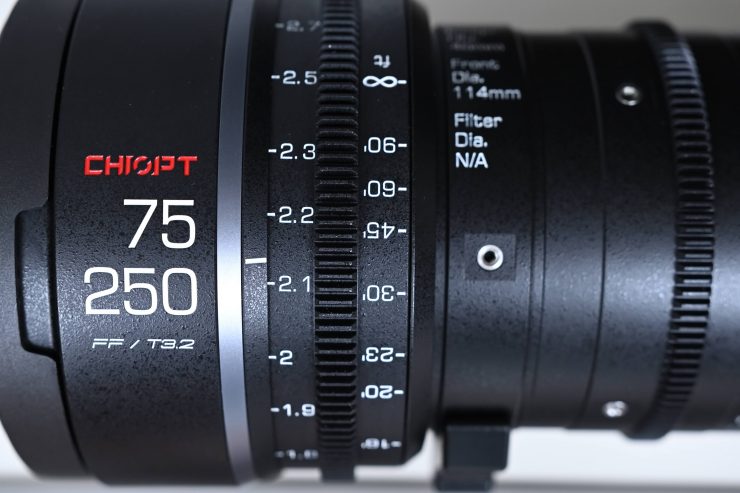
The 75-250mm T3.2 has a metric scale on the left side of the focus ring, and an Imperial scale on the right side. This is a little unusual in the cinema lens world, however, it is also something that DZOFilm also does with its Catta zooms. The Xtreme series lenses can either have left side metric and right side imperial scale versions, or customers can also choose to have their lens with both left and right Imperial scales.
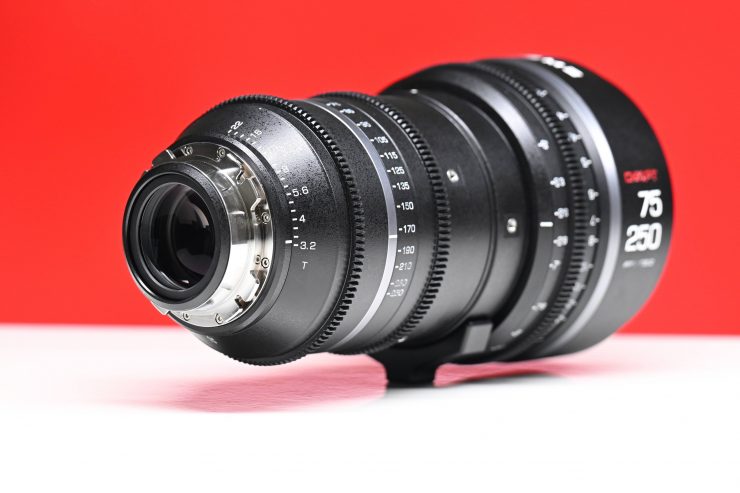
A PL native mount is standard, but you can also get the lens in Sony E-mount and Canon EF-mount as well.
There are also separately available Canon EF and Sony E mounts which cost $99 USD each. These are user-swappable mounts. CHIOPT states that other mounts will also be available in the future.
Is this a purpose-built cinema lens?

When I asked CHIOPT this question they told me that the lens was entirely designed and manufactured by CHIOPT.
Both the XTREME zooms are based on a T3.2 constant aperture design and feature an internal zoom structure. The lens is parfocal from my testing. It maintains focus regardless of the focal length.
I tested out the lens by doing large focus throws, and there certainly is a lot of breathing. The lens breathing is very reminiscent of the ZEISS 70-200mm T2.9 Compact Zoom CZ.2.
I personally don’t like focus breathing as it can be very distracting.
No lens technically has zero breathing, but very good cinema glass has such minimal amounts that it is virtually impossible to see. What you will normally see is some perspective shift which is normal when refocusing a lens.
Image shift is the change in location of a fixed point after a focus rack. It should be in the same spot after you rack focus.Perspective shift is the focal length of the lens being modified by the movement of the optics.
A slight change in focal length may happen if there is a floating element that moves and is not properly corrected for in the design. Certainly, the great majority of lenses have this issue. It’s also tenths of a mm so not overly noticeable.
Focus breathing is a change in image size so the size of the object will get larger as it moves out of frame. That is reproduction size.
In summary, perspective shift is the effective focal length change (angle of view change) and focus shift is the reproduction size of the object changing as focus moves. Think of it like Macro. A macro lens can be 1:1 life-size reproduction but as you focus it can change the reproduction size. That is focus shift from intentional breathing design. The angle of view is not overly affected in that case because it is flat field focus. On spherical lenses, the angle of view does change slightly as you focus rack thus making for perspective/angle of view shift.
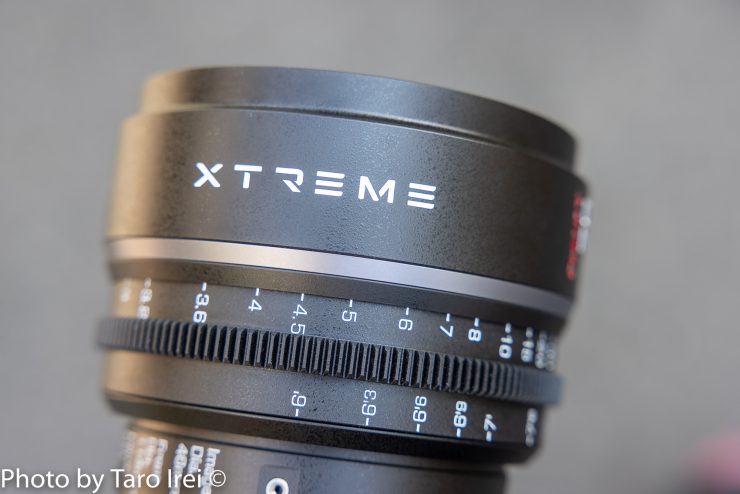
As the lens covers a 46.7mm image circle, when you use it on a full-frame-sized sensor you get very good illumination across the entire image.
I didn’t see any vignetting when shooting 6K 17:9 full-frame on the Kinefinity MAVO Edge. 75-250mm is also a great range on an S35-sized sensor camera.
The growing trend that is common with a lot of the affordable cine zooms and primes these days is to come up with something that is a little more vintage, and that sometimes comes at the expense of sharpness. I was curious to see if the CHIOPT followed that trend. Above you can see how the lens performs when used at various T stops at 250mm.
The lens is pretty sharp when used wide open at T3.2. At T5.6 it does get slightly sharper, but not by a considerable margin. The edge sharpness is ok, but it isn’t nearly as sharp as the center of the image. In saying that, you do need to crop into the image to really see the differences.
Above you can see how the lens performs when used at various T stops at 170mm.I found that at 170mm the lens was nice and sharp, even when used wide open.
Once you start stopping the lens down sharpness does improve as you would expect, but there isn’t a huge difference between T3.2 and T5.6.
Above you can see how the lens performs when used at various T stops at 75mm. At 75mm it still retains pretty good sharpness, but it does improve once you start stopping the lens down.
The edge sharpness is also pretty decent at 75mm.
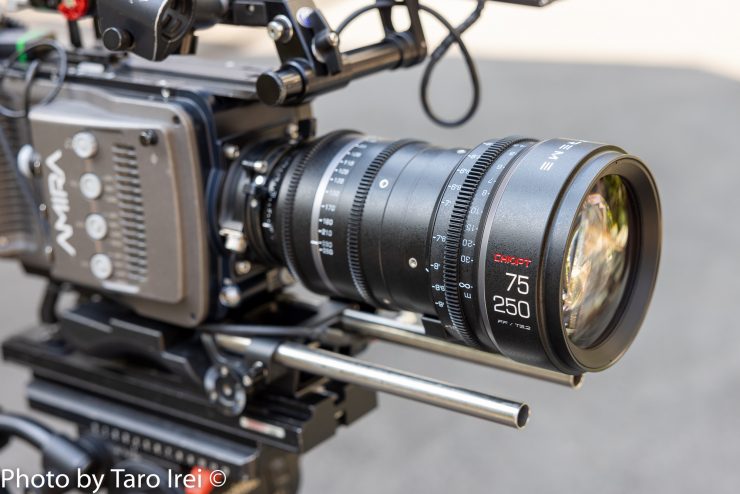
It was nice to see that the XTREME 75-250mm T3.2 retains good sharpness across its focal range. When I reviewed the XTREME 28-85mm T3.2 I found that the lens was quite soft when used wide open at longer focal lengths.
I do these types of tests so you can clearly see the sharpness differences at various focal lengths and T stops. You shouldn’t come to any conclusions from one set of tests, as often controlled tests don’t necessarily give you the full picture of any product.
Lens flare is not something that is that easy to critique or quantify. Everyone has different tastes and different opinions when it comes to lens flare. When using the lens at 250mm I personally found the flare to be ok. I say ok because while it can create some interesting flare if you get any direct light down the barrel you lose contrast. There is certainly some veiling as well, but some people like that.
When used wide open at 75mm the flare can interesting depending on where the light source is coming from. I want to reiterate again that lens flare is very much a personal thing and whether you like the flares this lens produces only you will know.

Nice bokeh is something everybody craves. The bokeh produced is reasonably round and there are no signs of onion rings.
I personally didn’t find the fall-off to be that pleasing. It goes from in focus to out of focus very abruptly. Again, this is just my personal opinion. You may think otherwise.

The CHIOPT XTREME 75-250mm T3.2, just like the 28-85mm T3.2 is fairly neutral when it comes to the color tone. It may lean a little more towards cooler tones, but I wouldn’t say it is as cool as a Zeiss.
The lens isn’t too clinical, especially when used wide open. What look you actually prefer from a lens is entirely going to come down to personal choice.

The color tone of a lens is really something you should look at closely if you are going to be using both prime and zoom lenses from different manufacturers.
Certain prime and zoom lenses work better together than others. What will work for you will also depend on what camera you are using.
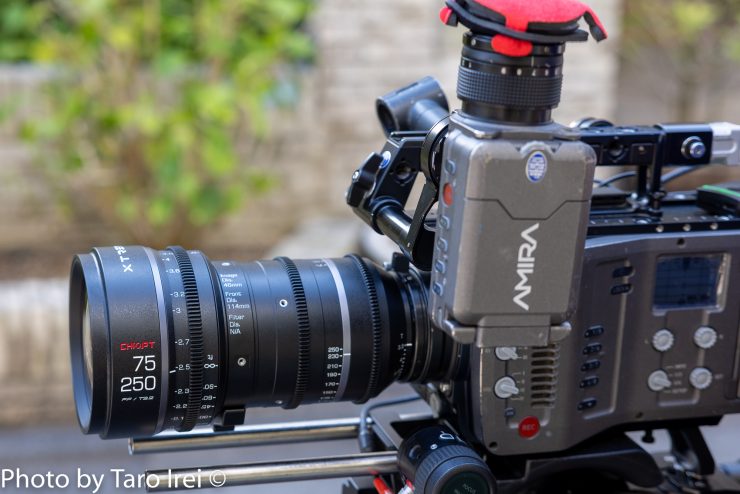
The CHIOPT 75-250mm T3.2 is a well-made full-frame cine zoom that would be right at home on cameras such as the Sony FX6, FX9, VENICE, RED V-Raptor, ARRI ALEXA Mini LF, Canon C500 Mark II, Kinefinity MAVO LF, EDGE, etc. It represents good value for money and it is bound to attract the attention of owner/operators who are looking for an affordable telephoto cine zoom. It is also a great option for use with S35 size sensor cameras as it offers a good amount of reach. CHIOPT also told me that they are in the process of making a 1.7x extender for the lens.
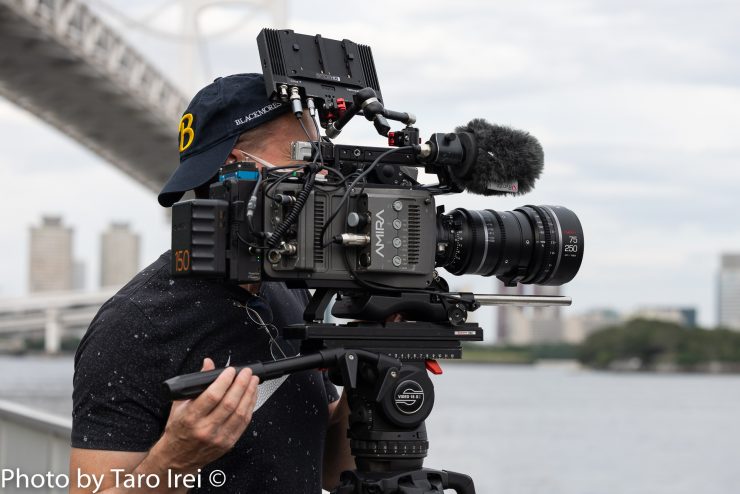
The lens is nice to operate and use, and the mechanics are good for a lens at this price.

The overall optical performance of this lens is pretty good, and it retains good sharpness even when used wide open. I found the focal range on an S35 camera to be great and it allowed me to get a wide array of shots without needing to change lenses.
There are no real-world signs of any chromatic aberration, but you do have to be aware of the breathing if you plan on doing large focus throws. breathing. The lens produces decent bokeh.


The CHIOPT XTREME 75-250mm T3.2 is a good option if you are looking for a solidly made full-frame cine zoom with a long focal range. When paired with the 28-85mm T3.2 you can get a decent combination for under $6,000 USD.
The lens is optically pretty good, and although the image quality isn’t going to be quite as good as lenses that cost significantly more money, it represents excellent value for money. There are no shortcuts with optics and in most cases, you really do pay for what you get, however, CHIOPT has done a very good job with the 75-250mm T3.2 considering its relatively low price.
The mechanics of the lens are pretty good and it has minimal real-world chromatic aberration. The focus breathing is fairly pronounced, but that is true of quite a few long zooms.
The 75-250mm T3.2 has a nice focal range and it works well on both Super 35 and full-frame sensors. This makes it a very versatile lens.
It is good to see more competition in the affordable full-frame cine zoom space and even more so, it is good to see companies making more wallet-friendly telephoto cine zooms. If you are an owner/operator, lenses such as the CHIOPT XTREME Zoom 75-250mm T3.2 make for an interesting proposition.